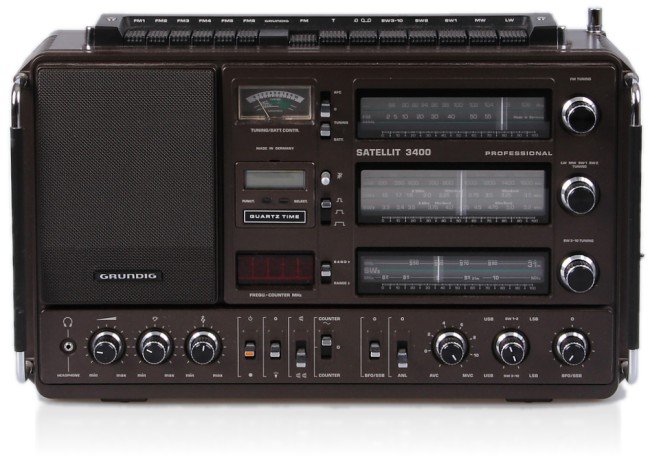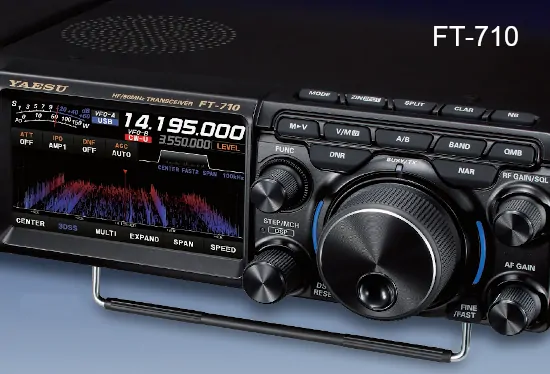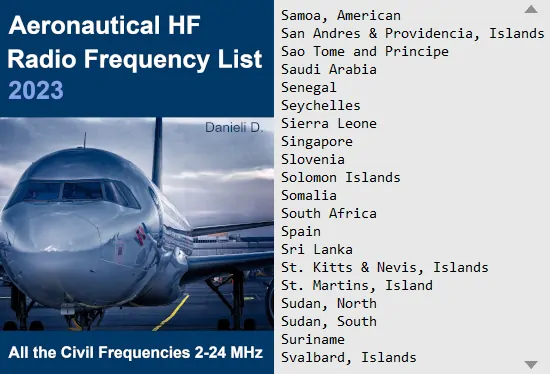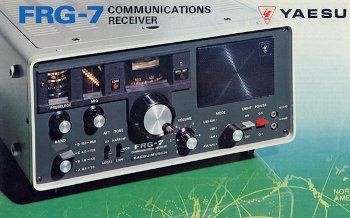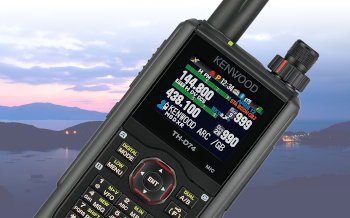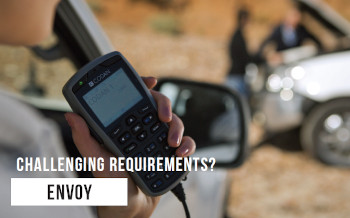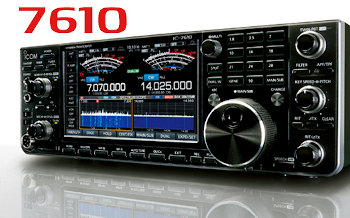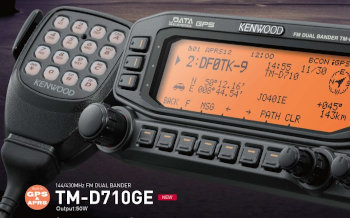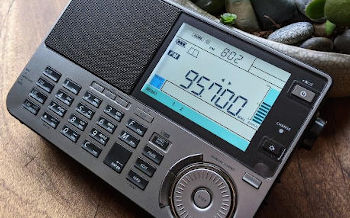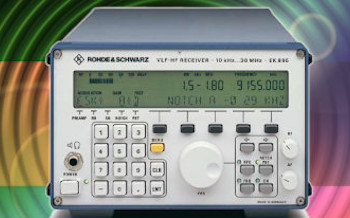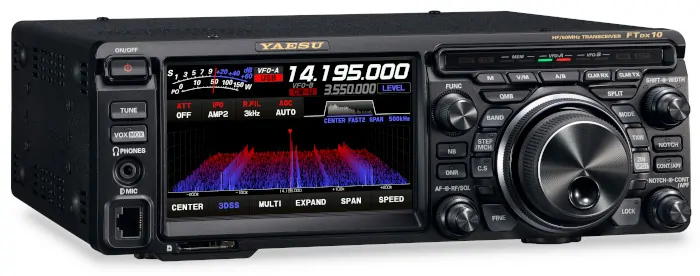
Compact 100W transceiver for HF / 50 / 70 MHz. Hybrid SDR configuration with narrow band receiver and direct sampling for real-time 3D spectrum scope. Roofing filters of 12 kHz, 3 kHz, 500 Hz. 116dB third-order IMDR, 141dB blocking. Ideated in Japan, year of introduction 2020.
Reference market : amateur-radio
FT-DX10 specifications
| General |
| Frequency coverage | |
|---|---|
| Receive | 0.0300 ~ 75.0000 MHz [1] |
| Transmit | 1.8 / 3.5 / 5.1675 [2] / 5.2 / 7 / 10 / 14 / 18 / 21 / 24 / 28 / 50 / 70 [3] MHz band |
| Mode | |
| CW / FSK (RTTY) / PSK / LSB / USB / AM / FM | |
| Tuning step | |
| 1 / 5 / 10 / 100 Hz / 1 / 2.5 / 5 / 6.25 / 9 / 10 / 12.5 / 20 / 25 KHz | |
| Receiver |
| Sensitivity | |
|---|---|
| SSB [4] | 0.16 uV (1.8~30 MHz, 10dB S+N/N, preamp2 ON) 0.12 uV (50~54 MHz, 10dB S+N/N, preamp2 ON) 0.16 uV (70~70.5 MHz, 10dB S+N/N, preamp2 ON) |
| AM [5] | 7.9 uV (0.5~1.8 MHz, 10dB S+N/N) 2.0 uV (1.8~30 MHz, 10dB S+N/N, preamp2 ON) 1.0 uV (50~54 MHz, 10dB S+N/N, preamp2 ON) 2.0 uV (70~70.5 MHz, 10dB S+N/N, preamp2 ON) |
| FM [6] | 0.25 uV (28~30 MHz, 12dB SINAD, preamp2 ON) 0.2 uV (50~54 MHz, 12dB SINAD, preamp2 ON) 0.25 uV (70~70.5 MHz, 12dB SINAD, preamp2 ON) |
| Selectivity | |
| CW [7] | > 0.50 KHz (-6dB)
< 0.75 KHz (-60dB) |
| SSB [4] | > 2.4 KHz (-6dB)
< 3.6 KHz (-60dB) |
| AM [5] | > 6.0 KHz (-6dB)
< 15.0 KHz (-60dB) |
| FM [6] | > 12.0 KHz (-6dB)
< 25.0 KHz (-60dB) |
| RF preamplifiers | |
| Preamp1 | ~10 dB |
| Preamp2 | ~20 dB |
| RF attenuator | |
| Yes | |
| DR (Dynamic Range) | |
| 109 dB (2 KHz spaced signals, 14 MHz) 110 dB (20 KHz spaced signals, 14 MHz) |
|
| RMDR (Reciprocal Mixing Dynamic Range) | |
| 116 dB (2 KHz spaced signals, 14 MHz) 122 dB (20 KHz spaced signals, 14 MHz) |
|
| Blocking | |
| 141 dB (2 KHz spaced signal, 14 MHz) | |
| Synthesizer phase noise | |
| -145 dBc@2 KHz (14 MHz) | |
| Image rejection | |
| > 70 dB (1.8~30 MHz, amateur bands) > 60 dB (50~54 MHz) |
|
| IF rejection | |
| > 70 dB (1.8~30 MHz, amateur bands) > 60 dB (50~54 MHz) |
|
| Notch filter | |
| Manual | Yes |
| Automatic | Yes |
| NB (Noise Blanker) | |
| Yes | |
| DNR (Digital Noise Reduction) | |
| Variable in 15 steps | |
| AGC (Automatic Gain Control) | |
| Off + time constant user selectable | |
| Frequency stability | |
| ± 0.5 ppm max with temperature from 0°C to +50°C after 5' warm-up | |
| IF (Intermediate Frequency) | |
| 1° | 9.005 MHz |
| 2° | 24 KHz |
| IF roofing filter | |
| 300 [8] / 500 Hz / 3 / 12 KHz | |
| CW features | |
| Decoder Spotting for zero-beating Semi break-in / full break-in 300~1050 Hz pitch control APF (Audio Peak Filter) Reverse mode LSB/USB |
|
| FSK features | |
| Decoder RTTY Normal or Reverse Mark frequency 2125 or 1275 Hz Shift 170, 200, 425 or 850 Hz |
|
| PSK features | |
| Decoder BPSK and QPSK mode |
|
| Transmitter |
| Output power | |
|---|---|
| SSB / CW / FSK / PSK / FM | 5 ~ 100 W |
| AM | 2 ~ 25 W |
| Spurious emission | |
| Harmonics | < -50 dB (1.8~29.7 MHz) < -63 dB (50 MHz) |
| Carrier suppression (SSB) | |
| > 60 dB | |
| Unwanted sideband suppression (SSB) | |
| > 60 dB | |
| Maximum deviation (FM) | |
| ± 5 / 2.5 KHz | |
| Microphone | |
| 600Ω (200 to 10kΩ) | |
| CW features | |
| 4~60 wpm keyer | |
| Antenna tuner | |
| Impedance range | 16-150Ω (1.8~29.7 MHz) 25-100Ω (50 MHz) |
| Features |
| Memory | |
|---|---|
| ? regular memories
3 band-stack memories 10 quick memory bank |
|
| Display | |
| 1 Hz frequency resolution | |
| Selective calling | |
| CTCSS | |
| Antenna | |
| SO239 50Ω | |
| Power supply | |
| 13.8 VDC ±15% | |
| Power consumption | |
| 2.5A RX, audio Off 3.0A RX, audio On 23A TX, max power |
|
| Audio power | |
| 2.5 W on 4Ω | |
| Audio output | |
| Jack 3.5 mm headphone
Jack 3.5 mm external speaker |
|
| Connections | |
| Jack 6.35 mm (key) Jack (remote control keypad) 6-pin Jack (TNC) 8-pin Jack (antenna tuner) 10-pin Jack (power amplifier) 16-pin Jack (accessories) DB-9 RS232C (PC) USB B (PC) 2 x USB A (keyboard and mouse) DVI-D (external display) |
| Mechanical and environmental data |
| Operating temperature | |
|---|---|
| from 0°C to +50°C | |
| Dimensions | |
| 266 (W) x 91 (H) x 263 (D) mm | |
| Weight | |
| 5.9kg |
- 1.8~29.7, 50~54, 70~70.5 MHz specified performance guaranteed.
- USA version.
- UK version.
- 2.4 kHz bandwidth.
- 6 KHz bandwidth.
- 12 KHz bandwidth.
- 0.5 KHz bandwidth.
- Optional.
Like the FT-DX101 series, the compact FT-DX10 utilizes the Yaesu Hybrid SDR configuration, narrow-band SDR and direct-sampling SDR. The narrow band receiver emphasizes excellent dynamic performance, while the direct sampling circuit provides a digital processing real-time spectrum scope. The down conversion type receiver configuration with the first IF at 9 MHz has been adopted. It makes it possible to incorporate 3 types of excellent narrow bandwidth crystal roofing filters that have the desired sharp cliff-edge shape factor. Thanks to the narrow-band circuit configuration, including an ultra-low-noise oscillator, the RMDR (Reciprocal Mixing Dynamic Range) reaches 116dB or more, the close-in BDR (Blocking Dynamic Range) reaches 141dB or more and 3rd IMDR (third-order Intermodulation Dynamic Range) reaches 109dB or more in the 14MHz band at only 2kHz separation.
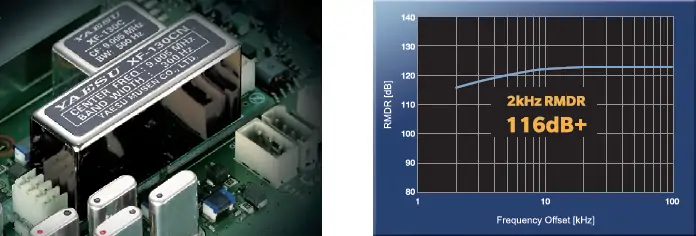
Yaesu FT-DX10 Crystal Roofing Filters (left) and 14 MHz RMDR (right)
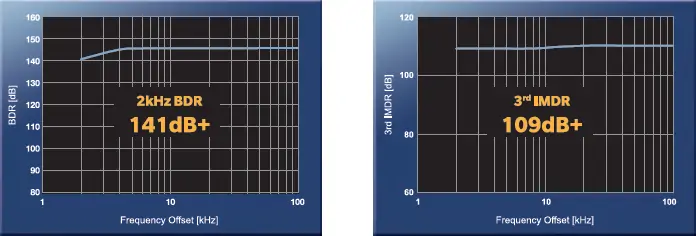
Yaesu FT-DX10 14 MHz BDR (left) and IMDR (right)
The local circuit of the new Yaesu FTDX10 uses 250 MHz HRDDS (High Resolution Direct Digital Synthesizer) method for quiet and clear reception. Thanks to its characteristics that improve the carrier-to-noise (C/N) ratio and the careful selection of components in the design, the phase noise characteristic of the local signal achieves an excellent value of -145dB or less in 14 MHz at 2 kHz separation.
The 12,7cm (5-inch) full-color panel TFT display shows the 3DSS (3-Dimensional Spectrum Stream) functionality. By touching the frequency display, the numeric keypad is displayed, and the active band and frequency adjustment can be set by direct input. Frequency setting and adjustment can also be performed by turning the main dial or touching the scope display. The Multi display, Receiver operation status display, Center, Fix and Cursor modes are available. More, front panel MPVD (Multi-Purpose VFO Outer Dial) is a large multi-purpose ring around the outside of the VFO dial that enables control of Clarifier, C/S (custom selection function) and recall of memory channels.
Remote operation of the FT-DX10 is possible with the optional SCU-LAN10 and SCU-LAN10 network control software. In addition to controlling the transceiver basic operations, the versatile scope displays enable sophisticated operations such as monitoring the band conditions on a large display at a location away from the ham shack by connection to a home LAN network.
FT-DX10 features :
15 Separate band-pass filters (BPF).
Effective QRM rejection with IF-DSP filters (Shift / Width, Notch, DNF, Contour, DNR, APF).
CW, RTTY (FSK), PSK encode/decode function.
Microphone amplifier with three-stage parametric equalizer.
High-quality and stable final amplifier utilizing the push-pull MosFET RD70HUP2.
Aluminum heat sink with 80mm low-noise axial flow cooling fan.
High speed automatic antenna tuner with a large capacity 100-channel memory.
Practical features such as quick split function, RF & AF transmit monitor, SD card slot.
Optional speaker: SP-30.
Optional 300Hz roofing filter: XF-130CN.
There are 15 band-pass filters (BPF) between the attenuators and the RF amplifier stages. These are divided into 10 band-pass filters dedicated to the amateur bands and 5 filters dedicated to the general coverage receives (GEN). BPFs are automatically selected according to the frequency band, to eliminate out-of-band unwanted signals and send the desired signal to the RF amplifier.
FT-DX10 intercept point optimization :
Depending on the antenna and the received signal conditions, the gain of the receiver RF amplifier section can be selected from 3 operating states to input a signal of the optimum level to the mixer. IPO (Intercept Point Optimization) is effective in severe reception conditions encountered on the low frequency bands. AMP1 (gain 10dB) provides a balance of sensitivity and characteristics by connecting one stage of RF amplification. AMP2 (gain 20dB) utilizes two stages of RF amplifier for greatest sensitivity.

Yaesu FT-DX10 receiver RF amplifier section
FT-DX10 IF-DSP :
The 32-bit high speed floating decimal point DSP, TMS320C6746 (maximum 2949 MIPS / 2220 MFLOPS) produced by Texas Instruments (TI), is used for the IF section of the FT-DX10. The signal processor operates at 368.64 MHz clock frequency. Yaesu's renowned interference reduction systems SHIFT, WIDTH, NOTCH, CONTOUR, APF, DNR, NB controls are all accessed from the front panel.
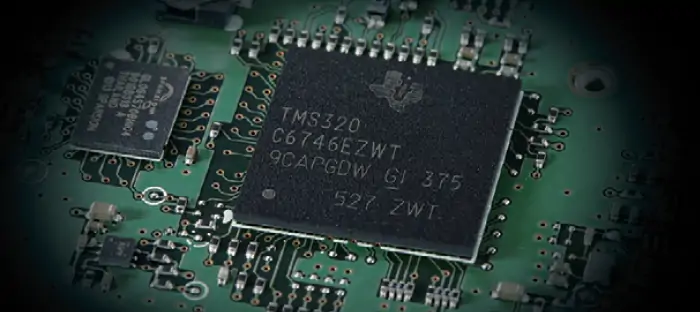
Yaesu FT-DX10 32-bit DSP
FT-DX10 IF-SHIFT / IF-WIDTH / IF-NOTCH :
Without changing the bandwidth, with the SHIFT control the pass band relative position can be moved, so that harmful signals are rejected from the low or high side of the pass band. By adjusting the bandwidth with the WIDTH control, interfering signals can be removed from both sides of the pass band, without changing the pass band position. Reception can also be improved by choosing to narrow the bandwidth of the IF-WIDTH function, and then varying the pass band with the IF-SHIFT.
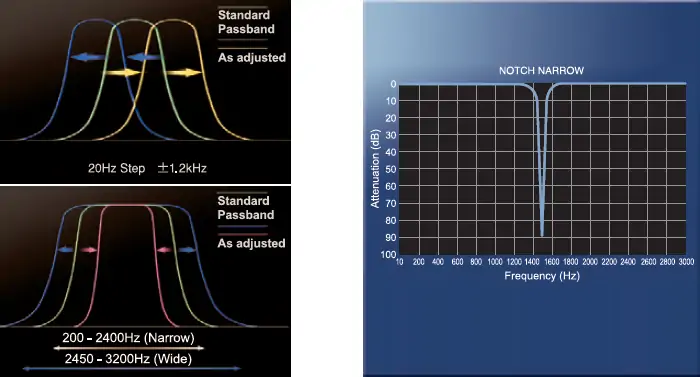
Yaesu FT-DX10 Shift, Width, and Notch
The NOTCH features a very high Q, and produces a deep narrow notch, that effectively removes a strong beat signal. The Digital Notch Filter (DNF) automatically follows the interfering heterodyne signals, even if there are more than one, and even if the beat frequency changes with time.
CW Decode, the transceiver CW decode function can decode the Morse code and show the characters and text on the display. CW zero-in display, side tone frequency can be adjusted between 300 and 105 0Hz. This pitch tone frequency is used as the reference in transmission, and so ensures that there is no difference between the TX and RX pitch. The FT-DX10 also has the CW tuning bar-display, to visually monitor and confirm the signal is zero beat with the programmed pitch.

Yaesu FT-DX10 CW zero-in bar display
CW Auto Zero-in measures the frequency of the received signal and tunes the beat frequency oscillator to match the programmed pitch frequency automatically. Even for the experienced operator, it is sometimes difficult to zero beat just by listening. This function enables zero-beat automatically with one touch, and the operator can begin the QSO very quickly. CW Keying signal form shaping by FPGA, the rise/fall time of the transmit signal during keying can be adjusted in four steps. In each setting, signal shaping by FPGA digital processing can produce a transmit signal with an ideal shape. Other features: Built-in Electronic Keyer (mode A, B, Y, ACS - 4 to 60 wpm) / Contest Memory Keyer / Bug keying emulation / Keyer Weight control / Keyer paddle Dot-Dash reversal / Contest number auto count up / Beacon function / Full break-in and Semi break—in / Direct keying function in SSB mode.
FT-DX10 FSK / PSK functions :
The Yaesu transceiver has a built-in encoder and decoder of FSK and PSK (BPSK, QPSK) digital communication modes for operation with RTTY and PSK31. The RTTY decoding and encoding functions can be easily tuned to the received signal using the marker on the filter function that is displayed together with the decoding screen. Mark frequency, SHIFT width and the Baudot code can be changed in the setting menu. Also, by connecting the transceiver to a PC with a USB cable, permits RTTY operation using available data communication software. RTTY and PSK text memory, each with a maximum of 50 characters for 5 channels, can store sentences that are frequently used in transmission. The pre-stored messages can be transmitted using the touch panel, or the optional FH-2 remote control keypad may be connected.
FT-DX10 microphone features :
The modulation circuit of the FT-DX10 utilizes a three-stage parametric equalizer that makes possible versatile digital variations of the audio quality, by shaping the band audio spectrum. The parametric equalizer can alter the Low, Mid and High audio frequencies separately. This three-stage parametric equalizer can generate high quality audio sound, because it can be finely tuned without sacrificing the audio integrity.
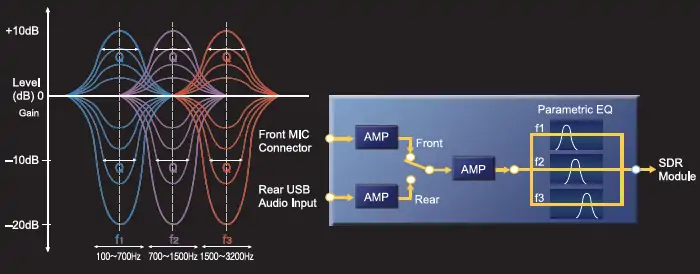
Yaesu FT-DX10 Microphone circuit Block Diagram and 3-stage Parametric Equalizer
The SSB Speech Processor uses IF signal processing to increase the intelligibility of the transmitted signal during weak signal crowded conditions. The Digital Signal Processor increases the average power of the important speech spectrum components, and reduces the transmit power of the less significant components. The compression level may be adjusted with the dial on the front panel to adapt the transmitted SSB signal to best suite the situation, propagation conditions and pile-up.
FT-DX10 high-power final amplifier :
The transmit final power amplifier stage utilizes a newly developed push-pull type Silicon MOSFET RD70HUP2, which is a small package with two MOSFETs, and has excellent linearity, low distortion, and stable 100 Watt high output, even at low voltage.
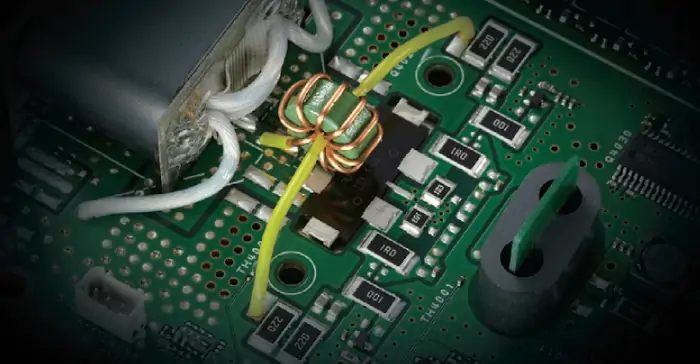
Yaesu FT-DX10 high-power, low-distortion, final amplifier's MOSFET RD70HUP2
The large aluminum die-cast chassis ensures a stable high-power output, even in continuous TX modes and operation under harsh environments. In addition, an 3.1-inch (80 mm) axial-flow cooling fan for the final amplifier is mounted at the rear. In prolonged operation, the temperature rise inside the cabinet is detected, and the fan starts. The rotation speed is automatically adjusted, depending on the temperature. The cooling fan uses a large bearing motor with low-noise and rotates at low speed, thereby minimizing the acoustic noise during quiet nighttime operation.
FT-DX10 automatic antenna tuner :
The transceiver internal antenna tuner uses microprocessor-controlled LC relay switching. Tuning data is automatically retained in a large capacity 100 channel memory. When changing frequency, the optimized antenna tuning data is immediately recalled to reduce tuning time, and realize the best matching point.
FT-DX10 remote operation :
Network Remote Control System (NRCS) permits FT-DX10 operation from a remote location via the LAN or the Internet. In remote operation the transceiver basic operations, the spectrum scope and the versatile displays enable sophisticated station control. Also, there are diverse enjoyable uses such as monitoring the band status on a large display at a location away from the Ham shack, by connecting to a home LAN network.

Yaesu FT-DX10 remote operation
FT-DX10 photo gallery :
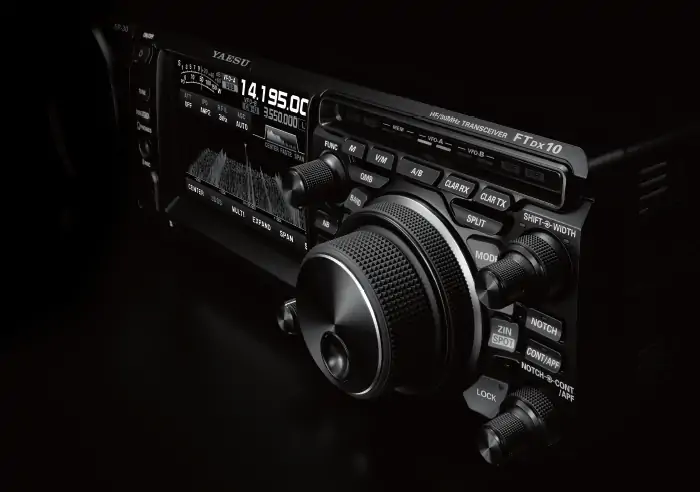

Yaesu FT-DX10 with Speaker SP-30
FT-DX10 price
We have collected for your convenience the Yaesu FTDX10 sale price (US Dollar) and its trend over time. Useful to guarantee a cheaper purchase of this radio and to put it for sale in the second-hand market. Of course offers, accessories, warranty terms and conditions can lead to different figures.
|
|
|
|
| USD 1599.90 | 2023-mar | Brand-new |
| USD 1699.95 | 2020-dec |
Brand-new Discount Price |
FT-DX10 review
| Jay | December-21 2022 |
The FT-DX10 is best HF transceiver I have owned to date, it's so quit and the transmit quality is perfect. This replaced my old 2015 IC-730.
[End post]
Your opinion on merits, defects, experiences, with this radio set is welcome. Write your review, after a technical evaluation by our staff if found suitable will be published on this page. We thank you for your precious contribution.
